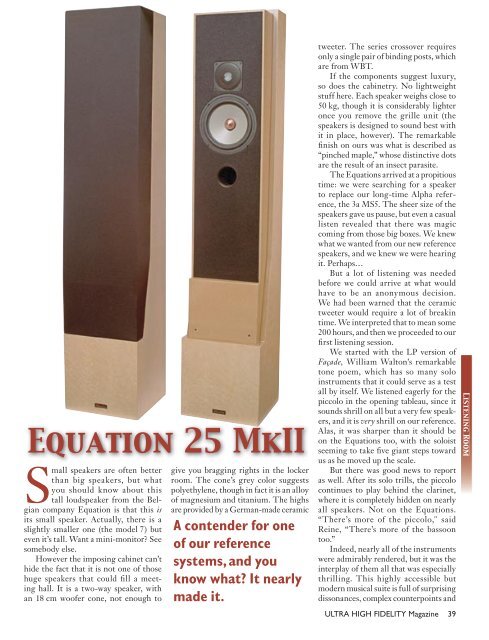UHF No 70 (Net).indd - Ultra High Fidelity Magazine
UHF No 70 (Net).indd - Ultra High Fidelity Magazine
UHF No 70 (Net).indd - Ultra High Fidelity Magazine
You also want an ePaper? Increase the reach of your titles
YUMPU automatically turns print PDFs into web optimized ePapers that Google loves.
Equation 25 MkII<br />
S<br />
mall speakers are often better<br />
than big speakers, but what<br />
you should know about this<br />
tall loudspeaker from the Belgian<br />
company Equation is that this is<br />
its small speaker. Actually, there is a<br />
slightly smaller one (the model 7) but<br />
even it’s tall. Want a mini-monitor? See<br />
somebody else.<br />
However the imposing cabinet can’t<br />
hide the fact that it is not one of those<br />
huge speakers that could fi ll a meeting<br />
hall. It is a two-way speaker, with<br />
an 18 cm woofer cone, not enough to<br />
give you bragging rights in the locker<br />
room. The cone’s grey color suggests<br />
polyethylene, though in fact it is an alloy<br />
of magnesium and titanium. The highs<br />
are provided by a German-made ceramic<br />
A contender for one<br />
of our reference<br />
systems, and you<br />
know what? It nearly<br />
made it.<br />
tweeter. The series crossover requires<br />
only a single pair of binding posts, which<br />
are from WBT.<br />
If the components suggest luxury,<br />
so does the cabinetry. <strong>No</strong> lightweight<br />
stuff here. Each speaker weighs close to<br />
50 kg, though it is considerably lighter<br />
once you remove the grille unit (the<br />
speakers is designed to sound best with<br />
it in place, however). The remarkable<br />
fi nish on ours was what is described as<br />
“pinched maple,” whose distinctive dots<br />
are the result of an insect parasite.<br />
The Equations arrived at a propitious<br />
time: we were searching for a speaker<br />
to replace our long-time Alpha reference,<br />
the 3a MS5. The sheer size of the<br />
speakers gave us pause, but even a casual<br />
listen revealed that there was magic<br />
coming from those big boxes. We knew<br />
what we wanted from our new reference<br />
speakers, and we knew we were hearing<br />
it. Perhaps…<br />
But a lot of listening was needed<br />
before we could arrive at what would<br />
have to be an anonymous decision.<br />
We had been warned that the ceramic<br />
tweeter would require a lot of breakin<br />
time. We interpreted that to mean some<br />
200 hours, and then we proceeded to our<br />
fi rst listening session.<br />
We started with the LP version of<br />
Façade, William Walton’s remarkable<br />
tone poem, which has so many solo<br />
instruments that it could serve as a test<br />
all by itself. We listened eagerly for the<br />
piccolo in the opening tableau, since it<br />
sounds shrill on all but a very few speakers,<br />
and it is very shrill on our reference.<br />
Alas, it was sharper than it should be<br />
on the Equations too, with the soloist<br />
seeming to take fi ve giant steps toward<br />
us as he moved up the scale.<br />
But there was good news to report<br />
as well. After its solo trills, the piccolo<br />
continues to play behind the clarinet,<br />
where it is completely hidden on nearly<br />
all speakers. <strong>No</strong>t on the Equations.<br />
“There’s more of the piccolo," said<br />
Reine, “There’s more of the bassoon<br />
too.”<br />
Indeed, nearly all of the instruments<br />
were admirably rendered, but it was the<br />
interplay of them all that was especially<br />
thrilling. This highly accessible but<br />
modern musical suite is full of surprising<br />
dissonances, complex counterpoints and<br />
ULTRA HIGH FIDELITY <strong>Magazine</strong> 39<br />
Listening Room

















